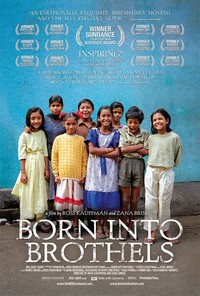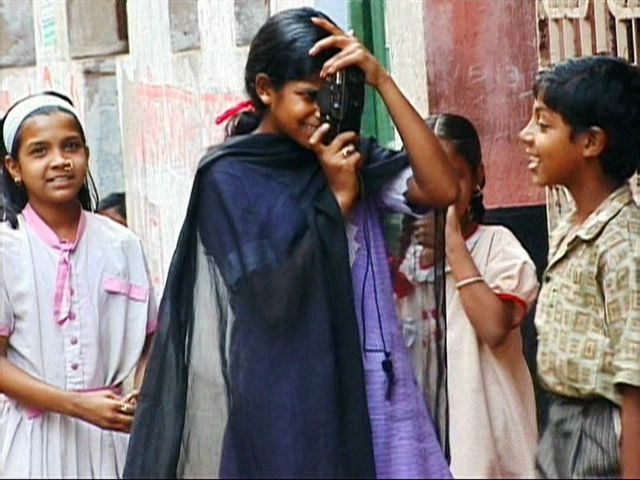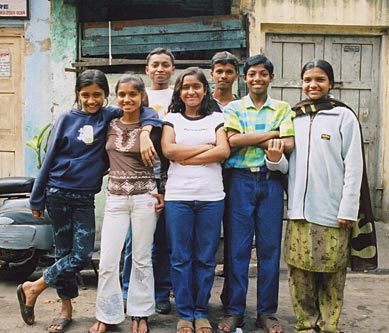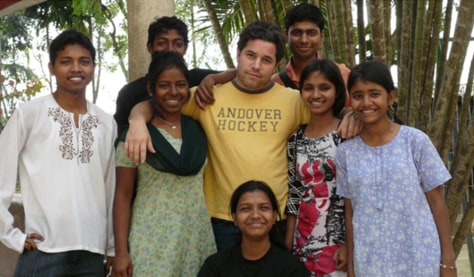Born into Brothels
Born in the brothel - Children in the red light district of Calcutta is an American documentary from 2004, the director Zana Briski accompanied children of prostitutes in Sonagachi, the red light district of Calcutta.. The film about eight children from 10 to 13 years was awarded the 2005 Academy Award for " Best Documentary ".
Prehistory
The photographer Zana Briski came to Calcutta in 1997 to photograph women from different castes for a project. When Briski stray into the red light district, she had initially thought to hold the prostitutes in pictures. Then Briski noticed the countless children on the streets of the Red Light District and began to deal with them. Many children were very interested in Briskis camera and so the photographer came back in the luggage cheap 20 mm cameras, which they distributed to the children. She explained to the children the functions of the camera and then sent them off to photograph everything they liked. Briski initially thought she saw neither the children nor the cameras again. But she was wrong and was getting all cameras. The children were very excited to see what they had photographed. The photographer realized in developing the photos the special charm of Images: The Red Light District from the eyes of children. Briski decided to help the children and document their stories. This created over the years, the documentary about the children of the red light district of Calcutta.
Action
The film begins with images from Sonagachi at night. Side by side, the women are at the edges of the road and offer up to the suitors. Briski reported from the brothels, which are full of children who live with their mothers there. A girl tells it like it is when a suitor comes. The 10 -year-old Puja introduces her friends, the camera displays during which, as the children photographed each other. Kochi is located on the floor, washes dishes and talks about her life and the fact that they would like to go to school. Briski to try and fit in a boarding school together with Kochi's grandmother, Kochi. Kochi's grandmother told in detail of the difficult family and why she rears and not of Kochi Kochi mother.
The photographer, known to the children, " Aunt Zana ", gives the children a photography course and discusses with them the negatives. The film shows Suchitra who barely leaves the house because her aunt " in the series", ie between the other prostitutes on the street wants to have. Suchitra would not want that. She is asked if she knows a solution, as it can prevent the prostitution. The girl denies this. Avijit tells how happy he paints, and talks about his father, who for years doing little else than smoke hashish. Briski takes repeatedly trips with the kids, so they have the opportunity to take pictures. You go to the zoo and the sea. The film shows quarrels and violence against children and against children in one of the brothels. Two women abuse is foul-mouthed, while the children play around them or interested in pursuing the dispute.
Briski continued to visit various boarding schools and talks to, among others, at a Christian boarding school. But the nuns do not want to take the children of prostitutes as a student and know no boarding, might have luck in the Briski. Other schools require birth certificates, ration cards or an HIV test before shooting. Briski tried to overcome all these bureaucratic hurdles to open the children access to a boarding school. In fact, she manages to get places for four of the girls.
Avijit is invited to become a member of the Children's Jury at the World Press Photo Exhibition 2002 in Amsterdam. To travel to Amsterdam, Avijit needs a passport. Also, this venture is a bureaucratic act that is nearly impossible due to Avijits origin. Briskis persistence pays off and Avijit can fly to Amsterdam.
Background
In India, the film may not be listed, even if he shows how children can leave the red light district and poverty through education behind.
Briski presented photos of the children in New York and Calcutta. Some of the photos were auctioned at Sotheby's, others were printed in a calendar of the organization Amnesty International. In 2002 Briski founded the Kids with Cameras project, which offers photography courses for disadvantaged children. In addition to photography courses in Kolkata, the project is now also active in Cairo, Haiti and Jerusalem.
One of the children from the movie, Avijit, after release of the film got a scholarship and, in 2005, for a year to visit a high school in the United States. Also Kochi made it to the United States and went from 2009 in Utah to a private school. Since July 2010 Avijit studied at the Tisch School of Art at New York University.
Awards
Born in the brothel - Children in the red light district of Calcutta won numerous awards. In addition to the Oscar for Best Documentary these included the National Board of Review Award, the Independent Spirit Award, which LACFA Award, Nestor Almendros Prize for Courage of the organization Human Rights Watch, as well as the Audience Award at the Sundance Film Festival. For this purpose, a nomination came at the DGA Awards.
Reviews
Wrote The Encyclopedia of the International film: "The film shows the development and emancipation of children documented their determination due to social circumstances, but also the ability to let go of the past. Furthermore, the film makes impressively creative potentials clearly that lie dormant in the children. "
The magazine Der Spiegel rated the film as " haunting and elegant as a good photo reportage".










